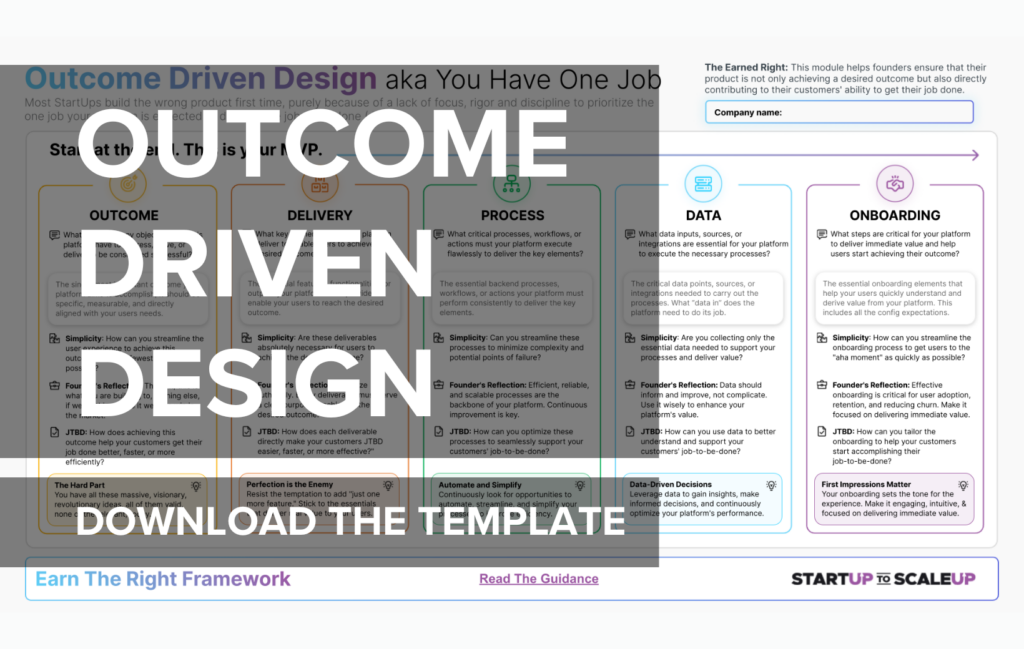How Can Startups Implement Outcome-Driven Design?
Why is outcome-driven design important for startups?
Outcome-driven design is crucial for startups because:
- Customer focus: It ensures products truly solve customer problems.
- Resource efficiency: It helps prioritize features that deliver the most value.
- Market fit: It increases the likelihood of achieving product-market fit.
- Competitive advantage: It creates products that stand out by delivering real value.
- Customer loyalty: Products that achieve desired outcomes foster user loyalty.
- Clear metrics: It provides concrete ways to measure product success.
- Innovation direction: It guides innovation efforts towards meaningful improvements.
By focusing on outcomes, startups can create products that truly resonate with users and drive business success.
How can startups identify the key outcomes their customers want?
To identify key customer outcomes:
- Conduct user interviews: Have in-depth conversations about customer goals and frustrations.
- Use the Jobs-to-be-Done framework: Understand what “job” customers are hiring your product to do.
- Analyze customer support data: Look for patterns in customer issues and requests.
- Implement surveys: Ask customers directly about their desired outcomes.
- Observe user behavior: Watch how customers actually use your product or similar solutions.
- Analyze competitive solutions: See what outcomes competitors are focusing on.
- Use social listening: Monitor social media and forums for customer discussions.
Focus on understanding the end results customers are trying to achieve, not just the features they think they want.
What’s the difference between feature-driven and outcome-driven design?
Feature-driven vs. outcome-driven design:
Feature-driven:
- Focuses on product capabilities
- Often based on competitor analysis or internal ideas
- Can lead to feature bloat
- May miss the core user needs
Outcome-driven:
- Focuses on user goals and results
- Based on deep understanding of user needs
- Prioritizes features that drive key outcomes
- Aligns product development with user success
Outcome-driven design ensures every feature contributes to meaningful user results.
How can founders balance business goals with customer outcomes?
To balance business goals and customer outcomes:
- Align metrics: Choose business metrics that reflect customer success.
- Create win-win scenarios: Look for outcomes that benefit both users and the business.
- Prioritize long-term value: Focus on outcomes that drive sustainable growth, not just short-term gains.
- Educate stakeholders: Help team members and investors understand the value of outcome-driven approach.
- Use outcome-based pricing: Tie pricing to the value customers receive.
- Implement feedback loops: Continuously gather and act on customer feedback.
- Balance the portfolio: Mix quick wins with longer-term outcome-driven initiatives.
The key is to recognize that long-term business success is inherently tied to delivering customer value.
What role does user research play in outcome-driven design?
User research is critical in outcome-driven design:
- Outcome identification: It helps uncover the real results users are seeking.
- Priority setting: Research reveals which outcomes are most important to users.
- Context understanding: It provides insights into the situations where users need your product.
- Assumption testing: Research helps validate or disprove your hypotheses about user needs.
- Iterative improvement: Ongoing research guides continuous product refinement.
- Persona development: It helps create detailed user personas based on desired outcomes.
- Competitive analysis: Research shows how well competitors are meeting user outcomes.
Thorough, ongoing user research is the foundation of effective outcome-driven design.
How can startups measure the success of outcome-driven design?
To measure outcome-driven design success:
- Define outcome-based metrics: Create KPIs that directly reflect user outcomes.
- Track user success rate: Measure how often users achieve their desired outcomes.
- Implement customer satisfaction surveys: Use tools like Net Promoter Score (NPS) to gauge overall satisfaction.
- Analyze feature usage: See which features contribute most to desired outcomes.
- Monitor customer retention: Track how outcome achievement affects long-term retention.
- Measure time to value: Assess how quickly users reach their desired outcomes.
- Collect qualitative feedback: Gather stories and testimonials about outcome achievement.
Regularly review these metrics to ensure your product is consistently delivering value.
How can startups apply outcome-driven design to their development process?
To apply outcome-driven design:
- Start with user outcomes: Begin product planning by defining desired user results.
- Create outcome statements: Clearly articulate the outcomes users want to achieve.
- Prioritize outcomes: Focus on the most important and underserved outcomes first.
- Map features to outcomes: Ensure each feature directly contributes to a desired outcome.
- Use outcome-driven roadmaps: Organize your product roadmap around user outcomes rather than features.
- Implement outcome-based testing: Evaluate new features based on how well they help users achieve outcomes.
- Foster cross-functional collaboration: Ensure all teams (product, design, engineering) are aligned on desired outcomes.
Make outcome-driven thinking a core part of your product development culture.
Implementing outcome-driven design is about shifting focus from what your product does to what it helps users achieve. Start by deeply understanding your users’ goals and the outcomes they’re seeking. Use this knowledge to guide every aspect of your product development, from initial concept to ongoing iterations.
Remember, features are means to an end – the end being user success. By consistently focusing on outcomes, you can create products that not only meet user needs but exceed expectations. This approach can lead to stronger product-market fit, higher user satisfaction, and ultimately, better business results.
Regularly measure and communicate the impact of your outcome-driven approach, both in terms of user success and business metrics. This will help maintain team alignment and stakeholder support for this user-centric methodology.
With persistence and a genuine commitment to user outcomes, startups can create products that truly stand out in the market and foster long-term customer loyalty.
